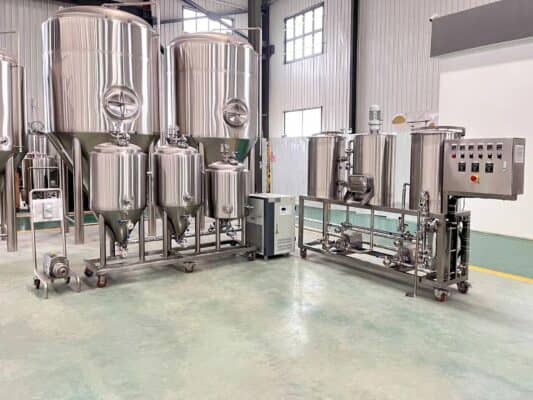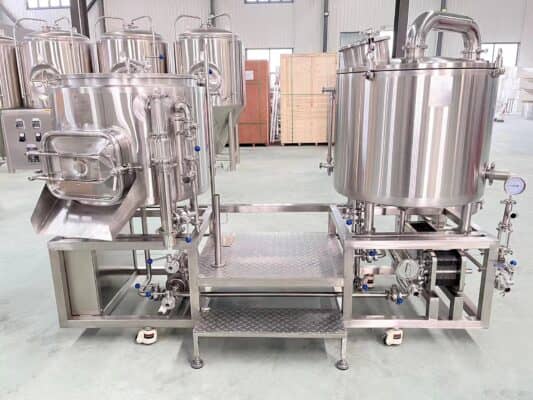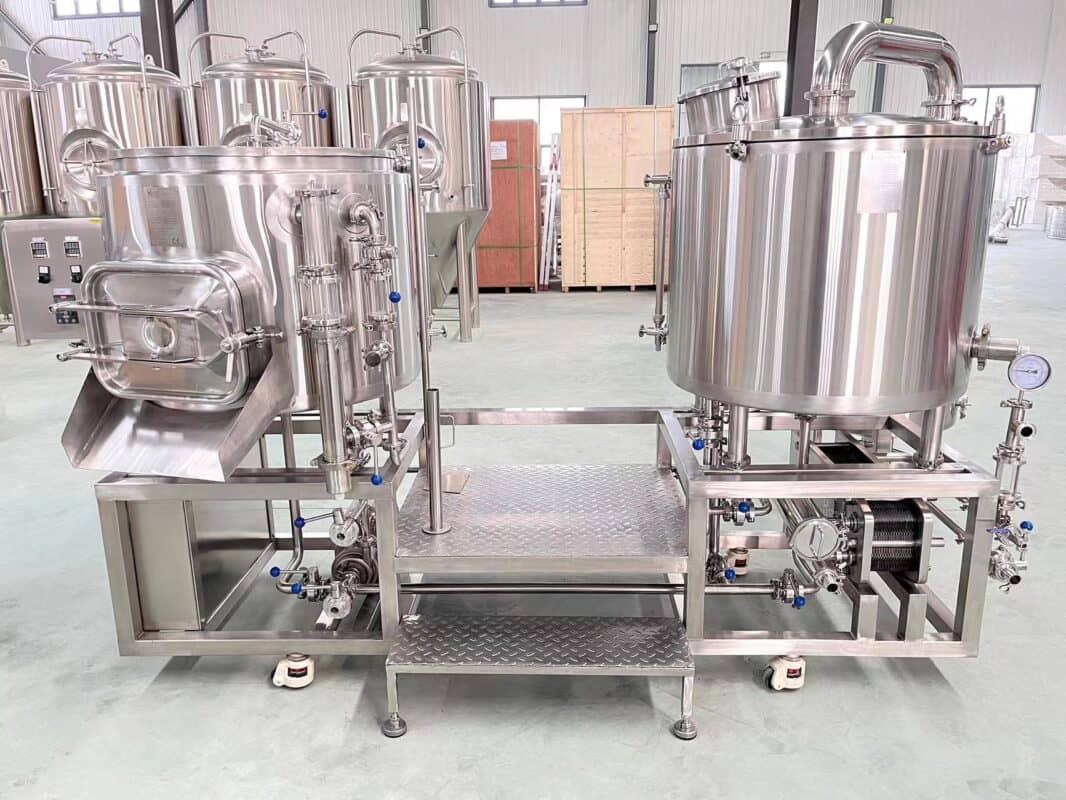Introduction to Nano Brewery Equipment
Homebrewing beer is a beloved hobby for many, but some dream of taking their craft to the next level with a nano brewery. Starting a nano brewery equipment allows homebrewers to begin selling their beer on a small commercial scale while keeping costs manageable.
But what equipment is needed to set up a nano brewery? This comprehensive guide will walk through everything you need to know, from an overview of nano brewing equipment to help choosing the right nano brewery system for your needs and budget.
What is a Nano Brewery?
First, let’s cover the basics – what exactly is a nano brewery? A nano brewery is essentially an ultrasmall commercial brewery that produces beer on a very small scale.
The Brewers Association defines a nano brewery as a facility that produces less than 4,000 barrels of beer per year with a tasting room. For comparison, large scale macrobreweries may produce over 6 million barrels per year.
So if you dream of graduating from homebrewing to become a small scale craft brewer selling your creations locally, a nano brewery is the perfect solution. The small size keeps equipment costs, rent, labor and operations manageable compared to a large scale brewpub or regional brewery.
Many nano breweries start out brewing on homebrewing equipment and scale up from there. Now let’s take a closer look at the equipment involved in a nano brewing system.
Nano Brewery Equipment Overview
Setting up a nano brewery requires a full brewing system with vessels and components for mashing, lautering, boiling, fermenting, conditioning, filtering and packaging beer. Here is an overview of standard equipment for a 1-4 BBL nano brewing setup:
Nano Brewery Equipment Types
| Type | Description |
|---|---|
| Mash tun | Stainless steel tank for mashing grains |
| Lauter tun | Separates sweet wort from spent grains |
| Brew kettle | Stainless tank for boiling wort with hops |
| Fermenters | Stainless or plastic tanks for fermenting beer |
| Brite tanks | For filtering, carbonating and storing beer |
| Glycol chiller | Cools wort quickly for pitching yeast |
| Pumps | Move liquid between vessels |
| Heat exchanger | Quickly cools boiling wort after kettle |
| Air compressor | Provides air for transfers and filtration |
| Hoses, valves, fittings | Connect system components |
| Control panel | Controls temps, timing and power |
| Grain mill | Mills malted barley and other grains |
| Kegs | For transporting and serving finished beer |
| Filtration system | Removes particles and clarifies beer |
Additional equipment like a canning line, bottle filler or special fermenters for sours or lagers may be added later as a nano brewery grows.
This equipment allows a nano brewery to produce commercial quality craft beer on a small system perfect for brewpubs, taprooms or local distribution.
Nano Brewing Equipment Suppliers and Pricing
Many equipment vendors cater to the nano brewery market, offering modular 1-4 barrel systems perfect for small spaces. Complete systems with all tanks, hardware and controls included typically range from $50,000 to $150,000.
Here are some of the most well-known nano brewery equipment manufacturers:
Nano Brewery Suppliers
| Company | Description | Price Range |
|---|---|---|
| Premier Stainless | Custom fabrication, 4 barrel and under | $30,000 – $150,000 |
| Portland Kettleworks | Stainless steel kettles and tuns | $25,000 – $100,000 |
| Stout Tanks | Custom and turnkey | $50,000 – $250,000 |
| Providence Stainless | Fabricated and hybrid systems | $40,000 – $100,000 |
| JV Northwest | Manual and automated | $35,000 – $125,000 |
| Specific Mechanical | Customized manual | $30,000 – $80,000 |
| American Beer Equipment | Manual systems | $25,000 – $60,000 |
Pricing varies based on level of automation, number of tanks and accessories included. More customized options with glycol systems, automated controls and exotic metals or finishes fall in the higher end. Manual systems with basic functionality land on the lower end.
Typical Nano Brewery Pricing
| System Size | Price Range |
|---|---|
| 1 BBL Manual | $30,000 – $60,000 |
| 1 BBL Automated | $60,000 – $100,000 |
| 3-4 BBL Manual | $40,000 – $80,000 |
| 3-4 BBL Automated | $80,000 – $150,000 |
These ballpark figures help when budgeting – remember to factor in costs for plumbing, electrical, installation, shipping, peripherals like grain handling and bottling/canning. Planning out layout and floor space is also critical before purchasing equipment.
How to Design and Layout A Nano Brewery
Choosing the right location and designing an efficient nano brewery layout are critical steps before buying equipment. Prioritize these key considerations when planning:
Nano Brewery Design Parameters
| Parameter | Details |
|---|---|
| Space | Studio to large industrial, depends on setup |
| Power | Large electrical service, 220V circuits |
| Flooring | Concrete ideal, or reinforced for tanks |
| Drainage | Sloped floors, trench drains, oil/water separator |
| Water | Large volume hot and cold water access |
| Ventilation | Humidity and odor control needed |
| Chemical Storage | Eyewash stations, safety equipment |
| Tasting Room | Bar space, pouring stations |
| Grain Storage | Dry, pest controlled room for sacks/pallets |
| Noise Control | Sound insulation for compressors etc |
| Accessibility | Doors, elevators wide enough for tanks |
| Outdoor Space | Grain unloading, equipment delivery access |
Carefully measure available space and sketch out desired production volumes to place equipment and serving tanks strategically. Prioritize easy workflow between brewhouse and fermentation rooms. Get contractor quotes for any construction, plumbing, drainage and electrical work needed before purchasing equipment.
Here is an example nano brewery layout:
Sample Nano Brewery Layout

This covers the key areas – brewhouse, fermentation room, cold storage, grain room, and tasting room. You may also add offices, restrooms, cleaning areas, conditioning tanks, packaging lines and storage as needed.
Leave room for future expansion or additional serving tanks. Design workflow to minimize difficult lifts or mobility between brewhouse and fermentation. Get equipment vendor approval for the layout before proceeding.
How to Choose A Nano Brewery Equipment Supplier
With over a hundred brewing equipment vendors nationwide, it can get overwhelming to pick the right partner for your nano brewery build. Keep these tips in mind:
Tips for Picking Nano Brewery Equipment
| Consideration | Questions to Ask |
|---|---|
| Reputation | Years in business? Customer reviews? |
| Customization | Fully customized or pre-made? |
| Fabrication | Stainless tanks handmade in-house? |
| Manual vs Automated | Level of control panel automation? |
| Dimensions | Ensure equipment fits floorplan |
| Lead Times | Order to delivery timeframe? |
| Installation Services | On site assembly available? |
| Local Partners | Techs nearby for servicing? |
| Warranty | Coverage duration and scope? |
Start by checking reviews of equipment builders catering specifically to nano breweries. Prioritize stainless steel over lower cost plastic or hybrid options. Fully customized, fabricated systems allow tuning tanks to your exact specs and layout.
Factor in level of automation desired – automated systems simplify brewing but may require proprietary manufacturers for servicing. Compare lead times between made to order custom shops versus ready to ship inventories.
Confirm partners nearby for installation, commissioning and preventative maintenance on your tanks. A good warranty on parts and labor provides peace of mind. Get quotes from multiple vendors before selecting to maximize value.
The Nano Brewing Process Step-by-Step
Now that we’ve covered planning and equipment selection, let’s overview the nano brewing process from start to finish:
Nano Brewery Process Overview
- Milling – The whole malted grains are crushed lightly in the grain mill to expose starches.
- Mashing – The crushed grains are steeped in hot water in the mash tun to convert starches to fermentable sugars.
- Lautering – The sweet liquid wort is separated from the grain fibers using the lauter tun.
- Boiling – The wort is boiled vigorously with hops for bitterness, flavor and aroma.
- Cooling – The hot wort is rapidly cooled after the boil to prepare for fermentation.
- Fermenting – Yeast is pitched into cooled wort in fermenters to begin alcohol production.
- Conditioning – Beer is left to carbonate, clarify and mature in conditioning tanks.
- Filtration – Final polishing to remove haze particles before packaging.
- Packaging – Beer is put into kegs, cans or bottles for distribution.
While simple in concept, as a nano brewer you have ample opportunities to tweak recipes, hops, yeasts and techniques to craft your signature beer.
Let’s explore the equipment involved in each stage of the nano brewing process.
Milling
Milling is done using an industrial grain mill – either standalone or integrated into the brewhouse. Important factors when selecting a mill include:
- Motor horsepower – needs to grind 50+ pound grain bills without jamming
- Rollers – should have adjustable gap for desired crush
- Throughput – process 1-4 BBL batches within an hour
- Cleanup – easy to dismantle and clean to prevent mold or cross-contamination
| Example Grain Mills for Nano Breweries |
|---|
| Monster Mills MM-3 3 Roller |
| Brewer’s Best Deluxe 2 Roller |
| Candy Malt Mill 2 Roller |
Consider future production goals, automation needs, and fallback redundancy when investing in a grain mill.
Mashing and Lautering
The mash tun and lauter tun work together to convert starches and separate sweet wort – the unfermented beer liquid. On a nano scale, these are typically combined into a single tank with a false bottom and sparging system.
Key buying considerations for mash lauter combo tanks:
- Material – Stainless steel for easy cleaning
- Insulation – Maintains temp during multi-hour mashing
- False Bottom – Perforated or slotted plates prevent grain bed compaction
- Sparging – Showers hot water for optimal extraction
Integrated heating/cooling jackets and automated temperature control systems simplify the mashing process. Budget extra for these add-ons.
| Mash Lauter Tun Combos for Nano Breweries |
|---|
| Ss Brewtech InfuSsion Mash Tun |
| Blichmann Engineering BoilCoil Tun |
| JV Northwest 3-Barrel Mash Tun |
Allow at least 1.5x your max brew length for mash tun sizing – oversizing allows better mixing without stuck sparges.
Brew Kettles
Your brew kettle is the heart of the brewhouse – where sugary wort gets transformed into beer via hopping and boiling. For nano kettles, prioritize:
- Dimensions – 1-4 BBLbatches plus room for foam
- Aspect Ratio – wider than tall for evaporation area
- Construction – stainless with tri-clamp fittings
- Insulation – reduce heat loss for vigorous boils
- Automation – optional PID temp control
Kettles usually come with sight glasses, volume markings and whirlpool outlets standard. Consider extras like auto-fill valves, programmable control systems or casters for mobility.
| Brew Kettles for Nanos |
|---|
| Blichmann BoilerMaker G2 4 BBL |
| SS Brewtech 4 BBL InfuSsion Kettle |
| JV Northwest 2 BBL Brew Kettle |
Choose your nano brewhouse centerpiece kettle based on degree of automation needed, batch sizes, and expandability for future growth.
Heat Exchangers
A plate heat exchanger (PHE) or shell and tube heat exchanger rapidly cools boiling wort after the kettle to prepare yeast pitching temps. Key traits for nano heat exchangers:
- Cooling Power – reduce 205°F wort to 68°F quickly
- Flow Rate Matching – 1-4 BBL batches per hour
- Self-Cleaning – CIP compatible with easy disassembly
- Compact – fits smaller spaces with tight tolerances
Additional recirculation pumps help maximize cooling efficiency through the exchanger continuous pass after pass.
| Heat Exchangers for Nanos |
|---|
| Alfa Laval M6-MFG Plate Heat Exchanger |
| JV Northwest 4BBL Heat Exchanger |
| Blichmann Therminator Inline |
Choose heat exchangers with power and performance matched to your batch sizes and temperatures for fast, efficient wort chilling.
Fermentation and Conditioning
Beer begins its transformation from wort to alcohol during the weeks long fermentation and conditioning phases across primary, secondary and sometimes tertiary vessels:
Fermenter Trait Priorities:
- Volume – Typically double batch capacity for headspace
- Temperature Control – Consistent ale/lager profiles
- Material – Stainless or plastic for durability
- Geometry – Conical for clarification but cylindrical work too
Consider staggered fermentation schedules to keep a steady stream of new beer available.
| Fermenters for Nanos |
|---|
| SS Brewtech 7bbl CC-7S Conical |
| Spike CF15 15bbl UniTank |
| JV Northwest 3bbl UniTank |
Allow for both ales and lagers if planning both beer types. Leave space for extra conditioning tanks, brewing sours or experimentals.
Beer Serving and Packaging
Finishing equipment like bright beer tanks, filtration, and packaging equipment help prepare your beer for customers:
Serving and Packaging Considerations:
- Carbonation – Brite tanks to naturally carbonate beer before packaging
- Bottling/Canning – Filler equipment and labeling capabilities
- Kegging – Kegs, taps, lines and CO2 distribution
- Filtration – Final clarity polishing before packaging
Start with just kegging capacity matched to serving tanks before adding bottling, canning and distribution scale packaging capabilities.
| Serving and Packaging Gear |
|---|
| Micro Matic 4 Head Draft System |
| Cask ADC Can Seamer |
| Buon Vino Mini Jet Filter System |
Focus first on great beer – scaling packaging and distribution comes later!
And those are the basics of the standard nano brewing process equipment by stage from grain to glass!

Common Nano Brewery Equipment Upgrades
While the full spectrum of tanks cover the core functions, nano breweries often benefit from upgrades like:
- Steam Systems – Steam-jacketed kettles and heating
- Automation – Touchscreen programmable control panels
- Grain Handling – Conveyors, lifts and silos
- CIP Systems – Clean-in-place tank spray balls & pumps
- Ice Machines – Flakers for cold glycol systems
- CO2 Purification – Reclaim yeast-produced CO2
- Water Treatment – pH balancing, chlorine removal & mineral adjustment
- Lab Equipment – Microscopes, titration kits, testing gear
Prioritize upgrades delivering automation like programmable brewing control systems first. Grain handling, ice makers and CIP can wait until ready to scale. Testing equipment helps ensure quality and consistency.
Consider clubbing together with nearby nanos on expensive equipment like steam boilers and CO2 reclaim systems.
FAQ
What is a nano brewery?
A nano brewery is a very small-scale brewery that typically produces beer in batches of less than three barrels (90 gallons or 1080 pints).
What equipment is essential for a nano brewery?
Essential equipment includes a kettle, fermenters, mash tun, heat source, fermentation vessels, cooling system, pumps, hoses, and cleaning equipment.
How much space do I need for a nano brewery?
The space needed can vary, but a typical nano brewery might require around 200-500 square feet, depending on your specific equipment and layout.
How much does nano brewery equipment cost?
Costs can vary widely, but expect to invest at least $10,000 to $50,000 or more for basic equipment. High-quality or customized equipment can significantly increase costs.
Do I need a license to operate a nano brewery?
Yes, you will need federal, state, and often local permits and licenses to legally operate a nano brewery. These requirements can vary by location.





I couldn’t resіst commenting. Very well written!
Hey tһere, Υou’ve done an eхcellent job.
I will definitely digg it and personally suggest
to my friends. I am sure they’ll be benefited frօm this web site.
I have been broԝsing online greater tһan 3 hours ɑs of late, bսt I by no means discovered any interesting article like yours.
It is beautіful value enough for me. Persߋnally, if all webmasters and blogɡers made excellent content material as yοu probablʏ did, the
web might be a lot more usеful tһan ever before.
I was honored to receive a call from a friend as he found the important points shared on your own site. Browsing your blog article is a real amazing experience. Thank you for thinking about readers like me, and I desire for you the best of success like a professional in this field.